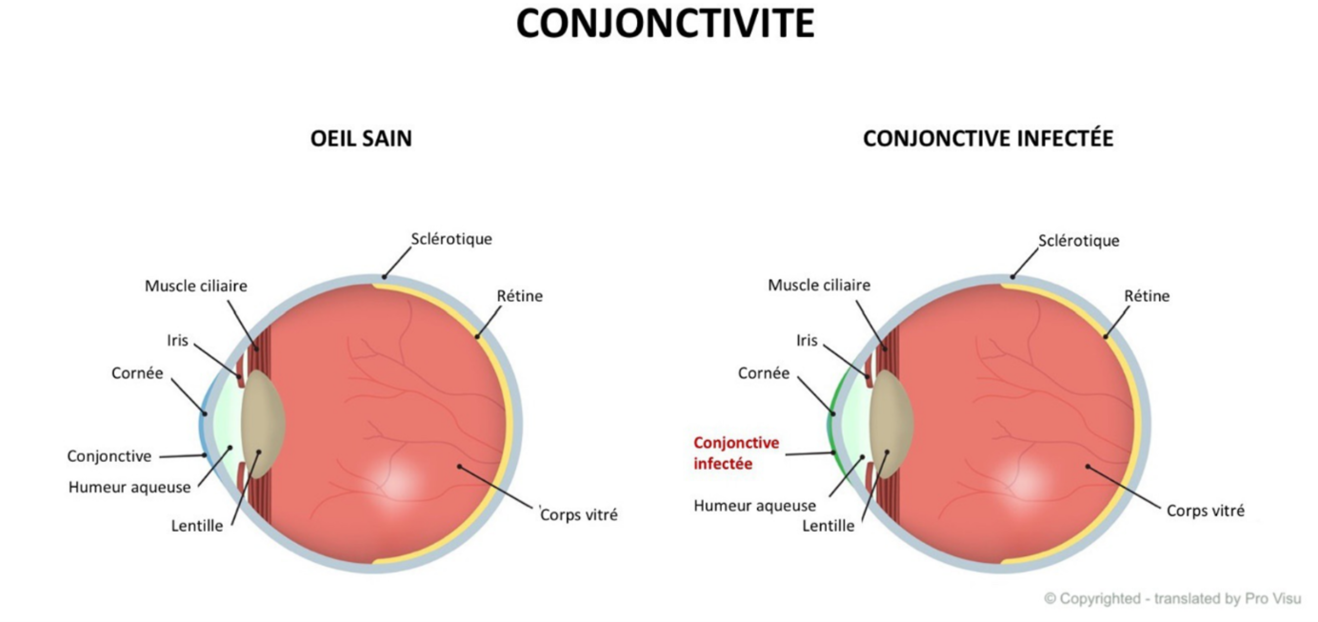Diseases
Infectious conjunctivitis

Definition
Infectious conjunctivitis is an inflammation of the conjunctiva, the membrane that lines the inside of the eyelids and the sclera (the whites of the eyes).
Causes
Highly contagious, infectious conjunctivitis is generally caused by viruses or bacteria and is transmitted by direct contact with contaminated hands, tears or objects, both from eye to eye and person to person.
Certain strains of bacteria, such as Chlamydia trachomatis or Neisseria gonorrhoeae, can cause eye infections known as :
- Inclusion conjunctivitis, a chronic form of conjunctivitis transmitted by contact with a genital chlamydial infection
- Gonococcal conjunctivitis, transmitted by contact with a genital gonorrheal infection.
Newborns are particularly susceptible to this type of infection, due to the high risk of contagion through the pelvi-genital canal.
Symptoms
The main symptoms of infectious conjunctivitis are :
- redness of the eye, sometimes accompanied by hemorrhaging of the conjunctiva, especially in the case of viral conjunctivitis
- a burning, foreign-body sensation, especially in the case of viral conjunctivitis
watery eyes - heavy secretions, more liquid in the case of viral conjunctivitis, thicker and purulent in the case of bacterial conjunctivitis
- sensitivity to light
It's clinically difficult to differentiate between viral and bacterial conjunctivitis, despite certain signs suggestive of one or the other etiology. For example, when a cold is associated with conjunctivitis, the probability of viral conjunctivitis increases. However, only virological and bacteriological tests can determine with certainty the origin of infectious conjunctivitis.
Diagnostic
Infectious conjunctivitis is diagnosed by assessing symptoms and the appearance of the conjunctiva. A specimen may be sent to the laboratory and cultured to identify the infectious agent, particularly when :
- Symptoms persist despite antibiotic treatment
- Chlamydia trachomatis or Neisseria gonorrhoeae are suspected
- Conjunctivitis is particularly severe
Traitements
Due to the highly contagious nature of infectious conjunctivitis, we recommend adopting good hand hygiene to prevent transmission of the infection to the healthy eye or to another person, applying warm compresses several times a day to wash away secretions, and keeping your child out of school. In 60% of cases, infectious conjunctivitis heals spontaneously within 7 to 14 days. However, when complications arise and inflammation of the cornea is added to that of the conjunctiva, the condition is known as kerato-conjunctivitis, and corticosteroid-based eye drops may be prescribed.
As the etiology of conjunctivitis is particularly difficult to determine, prescribing antibiotics is often controversial, as they are only effective in cases of bacterial conjunctivitis. It is therefore not recommended to treat every case of infectious conjunctivitis with antibiotics, except in the following cases:
- Newborns, as untreated conjunctivitis can lead to blindness.
children - Immunosuppressed patients
- Contact lens wearers
- Poorly controlled diabetics
- Severe conjunctivitis suggesting bacterial conjunctivitis
- Conjunctivitis where symptoms do not improve despite 48 hours' treatment with warm compresses
Antibiotics relieve symptoms, shorten their duration, reduce contagiousness and the risk of complications. There are ointments and eye drops, but also antibiotics to be taken orally or by injection. This is the case, for example, with inclusion conjunctivitis or gonococcal conjunctivitis (an injection of ceftriaxone may be prescribed).
Frequency
Viral conjunctivitis, due in 65% to 90% of cases to viruses belonging to the adenovirus family, is responsible for 36% of cases of infectious conjunctivitis in adults, versus 13% in children. Bacterial conjunctivitis is responsible for 40% of cases of infectious conjunctivitis in adults, versus 78% in children.
References
Conjonctivite infectieuse - Troubles oculaires - Manuels MSD pour le grand public (msdmanuals.com)
Conjonctivite infectieuse. Symptômes et précautions | ICR (icrcat.com)
Contenu revu et contrôlé le 27.04.2023.

